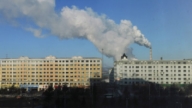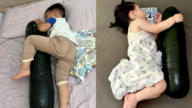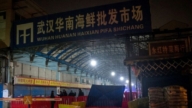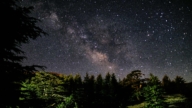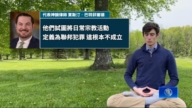【新唐人2011年3月24日讯】早在2004年,发改委就提出要开发怒江,因为遭到各方的强烈反对,而暂时搁置。今年初,中共能源局官员放出口风,要开发怒江,这引起多位专家的反对。什么原因呢?让我们一起去看看。
怒江是中国西南部唯一还没有兴建水坝、保存完好的原始生态流域,和金沙江、澜沧江一起从青藏高原流入滇西北横断山脉纵谷之中,形成著名的世界自然遗产——三江并行的景观。
能源局表示将要开发怒江,这消息让两位已经退休10多年的老科学家坐不住了。年初,77岁的徐道一和78岁的孙文鹏专程去怒江地区实地考察。他们从学术角度指出,从怒江独特复杂的地质环境,和当地地质灾害的严重性来看,怒江上建坝的地质风险非常大。
四川地矿局总工程师范晓接受新唐人采访表示:“实际上怒江就是欧亚板块和印度洋板块很重要的过渡的地方。就像现在日本大地震它发生在欧亚板块和太平洋板块结合的部位,那么怒江这个地方实际上也是很重要的大的板块结合带的附近。”
据研究发现,在怒江流域的很多横剖面上,宽度在100米以上的大断裂有2∼3条,还有30多个小破裂面,整个河流的构造上,破碎带的宽度在400∼1000米。孙文鹏认为,如果在怒江上建水电站,拦江大坝必然要横跨断裂破碎带。他形容这“相当于在剪刀口上建大坝。”
虽然他们的观点赢得了不少专家的赞同,但是,对于建水电站的“主上派”专家却说,“沿江仍能找到若干建设条件好的河段建坝”、“坝质采取安坡稳定加固,是非常有效的。”范晓认为:不能只从建坝地段和坝体牢固的角度来分析,还要看到怒江流域正处于地震活跃期。
范晓:“它属于滇西地震带,历史上多次发生7级以上的地震,前不久的盈江地震实际上就是(发生)在大盈江断裂,都是表明整个滇西地区,包括怒江断裂在内,都是地震非常活跃的一个区域。”
徐道一和孙文鹏分析也认为,若在这建坝,一旦发生地震,很可能上游一个大坝溃坝后引起多个大坝的连环溃坝,数十亿立方米的泥石流,沿着又陡又直而且狭窄的怒江河谷下来,会把下游地区彻底毁灭。
范晓认为,即便是在工程上能做到大坝牢固,但只要发生地质灾害,还是能对周围的环境造成强烈的破坏。
范晓:“他没考虑整个这个区域如果发生大的地震,因为它高山峡谷地区,即使大坝不破坏,因为大的地震可以诱发大陆的地震灾害,包括山崩、滑坡、泥石流,也会对区域造成一个重大的损害。”
据了解,即便不考虑这一切地质灾害,现代科学已经认识到,水库本库也能够诱发库区附近岸坡的大面积滑坡,滑坡又可能造成很高的库区涌浪,冲击和威胁大坝的安全。
新唐人记者赵心知、朱娣采访报导。
Nu River, New Dams Not Safe
As early as 2004, due to strong opposition,
a proposal to develop the Nu River was delayed.
In early 2011, Chinese energy officials started to
mention development of the Nu River again,
but many experts objected. What are the reasons?
The Nu River is the only river in southwest China
with no dams, remaining a pristine ecological basin.
Together with Jinsha River and Lancang River,
the Nu River flows into Northwest Rift Valley,
from Qinghai-Tibet Plateau, thus creating
the world famous Three Parallel River landscape.
China’s Energy Bureau said it will develop Nu River,
and two retired scientists became restless.
In early 2011, Xu Daoyi, 77, and Sun Wenpeng, 78,
made a trip to conduct a survey on the Nu River area.
They pointed out that it is a great risk to build a dam
from an academic point of view, and considering all
complex geological environment and potential risks.
Chief Engineer of Sichuan Geology and Mineral’s
Bureau, Fan Xiao, told NTD, “The Nu River
is a very important transitional area between
the Eurasian and Indian Ocean plate,
just like the site of Japan’s recent earthquake,
between the Eurasian and Pacific Ocean plate.
Geologically, Nu River is near such a critical area.”
Research of the cross sections of Nu River Valley
found that there are 2-3 100 meter-wide breakages,
and over 30 smaller breakages. The section
with breakages runs about 400-1000m. It would be
very dangerous to construct a hydropower station
on the Nu River, says Sun Wenpeng.
Building a dam across the fractured zone is like
“building a dam across scissors’ blades”.
Although many experts agreed with them,
those in favor of building the dam said,
“There are many good dams along the river”,
“If the slope is stabilized, it should be effective.”
Fan Xiao said, the dam site and stability alone
aren’t enough. The Nu River is in its seismic active
period, which should be taken into consideration.
Fan: “This is western Yunnan’s earthquake zone.
Many earthquakes of magnitude 7+ took place here.
Not long ago, an earthquake occurred due to
the Da-Ying River. This indicates that the entire
western Yunnan, including Nu River fracture,
is in a very active quake zone.”
Xu Daoyi and Sun Wenpeng also believed that
if an earthquake occurs, a collapsed upstream dam
could cause the other downstream dams to collapse.
Billions of cubic meters of debris, along the straight,
steep and narrow river would destroy the entire valley.
Fan believes that even if one builds a stable dam,
in case of a geological disaster, the surrounding
environment would be damaged immensely.
Fan: “They didn’t consider what would happen
to the area if a major earthquake should occur.
Due to high mountains and the gorges in the region,
even if the dam stands solidly, a huge earthquake
could induce disasters like landslides and mudslides.”
Even without considering all geological hazards,
modern science has realized that the reservoir itself
could also induce large-scale landslides in the area.
In turn, they could result in a high reservoir surge
that would threaten and impact the dam’s safety.
NTD reporters Zhao Xinzhi and Zhu Di




